The epic Routeburn Track is said to be among the best of New Zealand’s Great Walks. In this post, we cover what you need to know for hiking the Routeburn Track, and our 3 day/2 night self-guided hike-and-camp itinerary, from Routeburn Flats to The Divide.
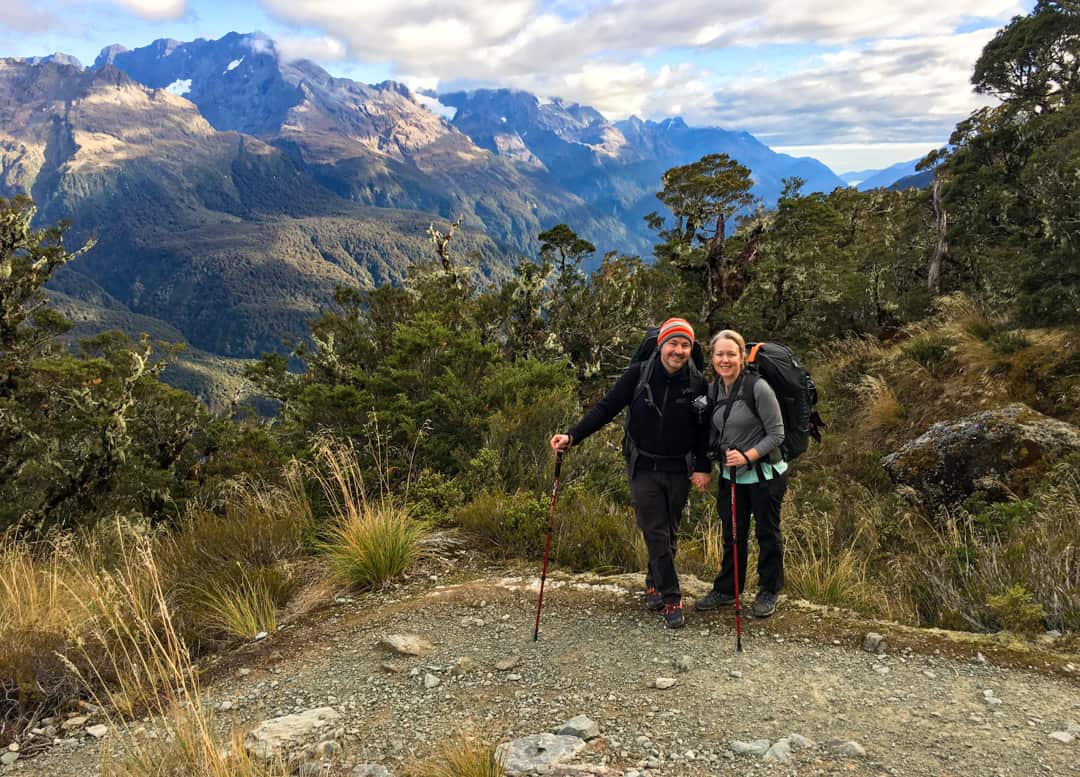
One thing we’ve discovered travelling New Zealand is that adjectives very quickly fall short. There are only so many words that can truly express the awe we feel around almost every bend in the road in this gorgeous island nation. After a while, we’re usually reduced to gasps, wide eyes and strange noises to share our appreciation of the scenes unfolding around us.
That sense went into overdrive recently when we explored the spectacular mountainous landscapes of Southland on New Zealand’s South Island, where snowy alpine ranges meet glacier-gouged valleys and fjords.
It’s here in this eye-popping corner country that you’ll find several of New Zealand’s Great Walks, including the renowned Routeburn Track, acclaimed by many as the country’s best multi-day hike.
As our first NZ Great Walk, we knew we were in for a treat. The Routeburn Track passes across the mountain ranges and valleys of Te Wāhipounamu–South West New Zealand World Heritage Area: three days and 33 kilometres of eye-wateringly beautiful landscapes.
It literally took our breath away. A good thing too, because, well, words just weren’t enough.
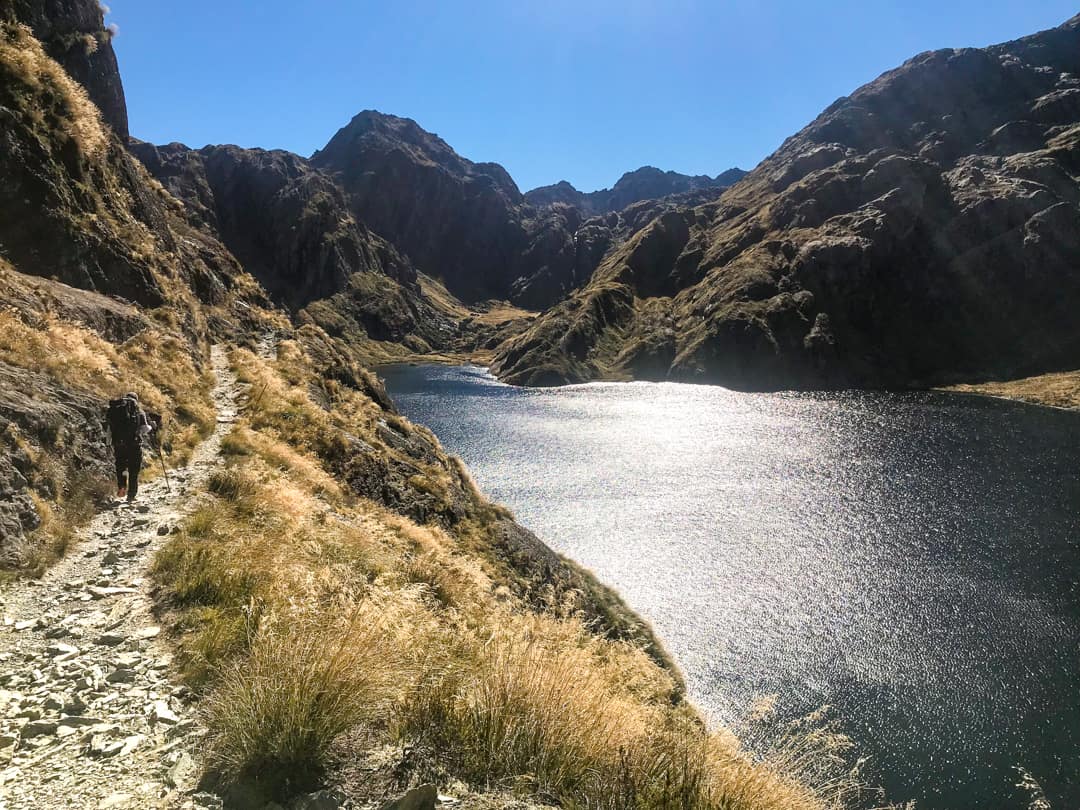
What You Need To Know About The Routeburn Track
Where Is It?
The Routeburn Track runs between the Routeburn Shelter in Mount Aspiring National Park, 70km north-west of Queenstown, and The Divide in Fiordland National Park, 85km north of Te Anau (and 35km south of Milford Sound).
How Long Does It Take?
At 33km, the Routeburn is typically hiked over three days and two nights. Unless you’re an endurance runner, in which case you can do it in a day. As Arya Stark would say though, that’s not me. Or us.
Of course, you can also take your time, stay more nights, do more side hikes, and really immerse in this incredible setting. It’s entirely up to you.
Which Direction Should I Walk?
You can hike the Routeburn Track in either direction, starting at Routeburn Shelter or The Divide.
Both ways involve steady upward stretches and knee-busting downhill sections. Both directions climb to the track’s highest point, Harris Saddle, at 1,255m, before mostly descending on the other side.
We chose to hike from Routeburn Shelter to The Divide (north-east to south-west) purely to suit our South Island road trip itinerary.
As the trail is point-to-point (rather than a loop), the road distance between each point is over 320km, and there’s no public transport to either of the trailheads, whichever point you start at, you’ll need to arrange transport to get to and from both ends. We talk about this further on.
Is It A Difficult Hike?
The Routeburn is described by NZ’s Department of Conservation (DOC) as intermediate, meaning it’s suitable for trampers with some remote area hiking experience, and a reasonable level of fitness.
The track is very good (though weather can work it over in places), the wayfinding is great, with orange poles and triangles marking the track throughout, and it has bridge crossings over major waterways so you don’t need to get your feet wet.
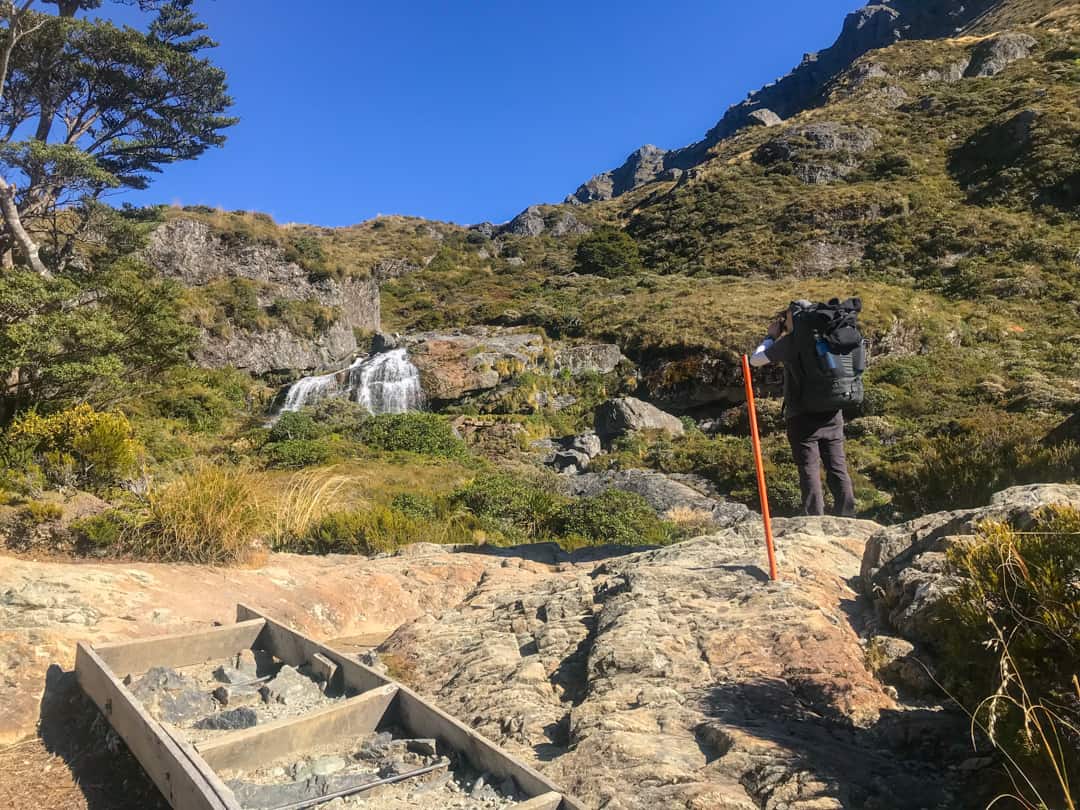
As irregular hikers with a fair level of fitness, we found the trail varied from easy tramping to quite challenging upward climbs, and tricky downward stretches where loose, rubbly rock forced us to slow down to avoid twisted ankles or painful knees.
Just remember, the signposted hiking times on the track (and the times we’ve included here) are guides only. This is your hike, enjoy it at your own pace.
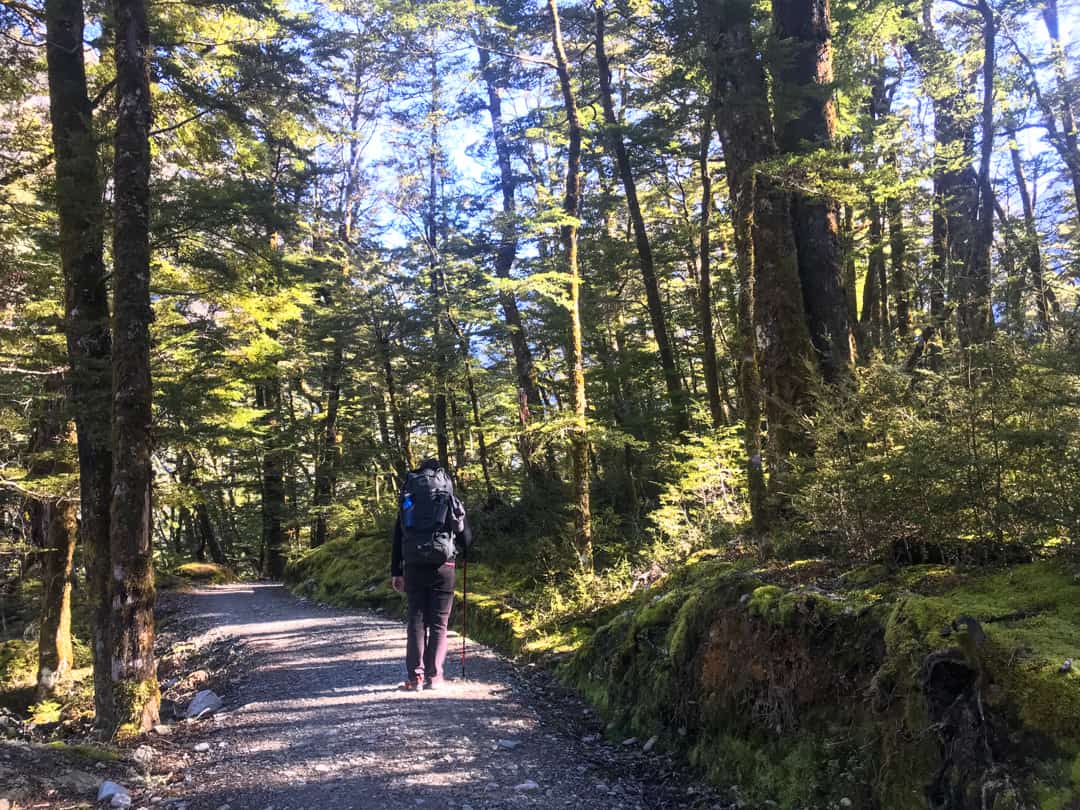
When Is The Best Time For Hiking The Routeburn Track?
While the Routeburn can be attempted year-round, it’s important to note the DOC recommends people hike during the Great Walks season, which runs from November to April.
Routeburn weather is highly changeable anyway, but outside of the Great Walks season, you’re contending with colder, wetter conditions, shorter days, heavy snow, and a greater chance of avalanches and flooding.
Off-season, there are no rangers staying at the huts, and hut facilities are scaled right back (even the flush loos are taken out of service).
Out of season tramping here has greater risks; it’s for experienced backcountry hikers. Contact the DOC for advice if you’re considering hiking the trail from May to October.
Where Do I Stay? And Should I Camp Or Stay In A Hut?
The Routeburn Track offers self-guided trekkers the option of camping or hut stays. There are a couple of beautiful lodges on the track too, but these are the domain of an upmarket guided trek experience.
Whether you choose hut or tent (or both) is up to you, but a couple of factors come into play: cost, comfort, availability, how far you want to walk each day, and how much you want to carry.
There are four huts and two campgrounds along the trail.
The huts, at Routeburn Flats, Routeburn Falls, Lake Mackenzie and Lake Howden, can be heated and have shared rooms with bunks, toilets (no showers), cold running water and basic facilities for cooking. You’ll still need to bring a sleeping bag, food and cooking utensils.
Things are very different in the huts out of season, so check the DOC website for more details if you’re thinking of hiking May to October.
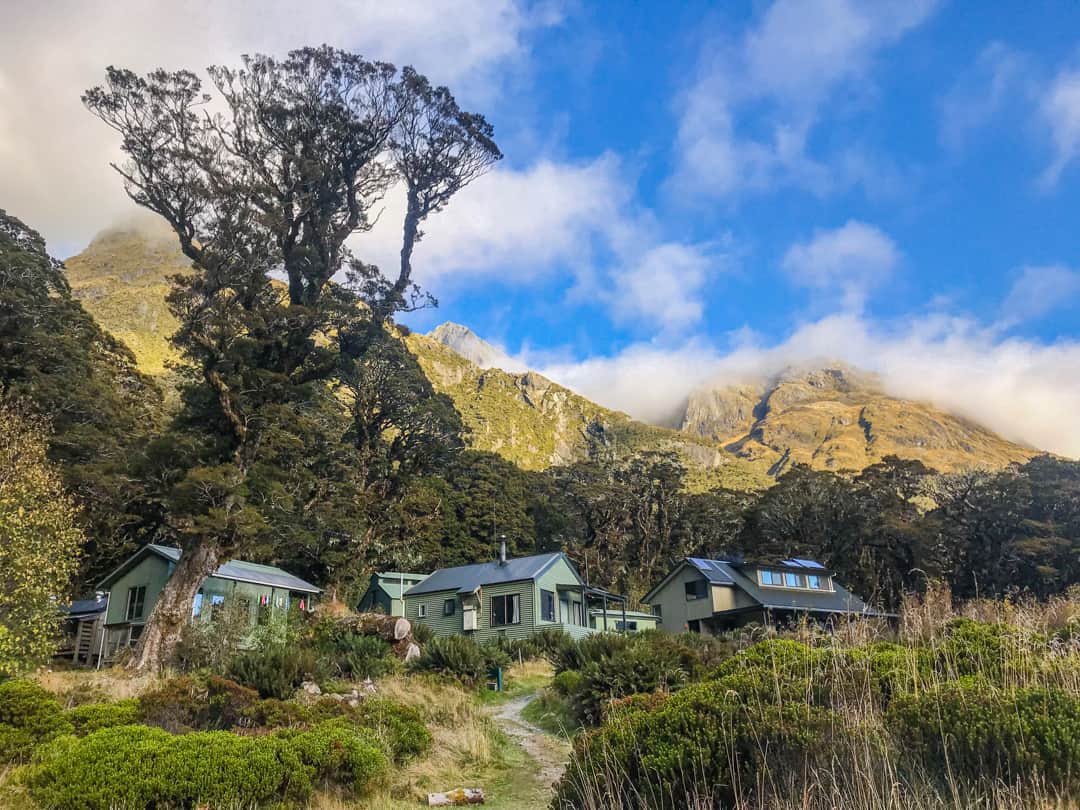
The camping areas are located at Routeburn Flats and Lake Mackenzie, both about ten minutes away from the huts. There’s no freedom camping on the Routeburn, you have to stay in the designated camping areas.
The two campgrounds are quite different from each other (we talk about this in more detail in the itinerary below), but both have drop toilets and shelters with sinks and cold, running water.
If you’re hiking independently, and regardless of whether you’re planning to stay in a hut or camp, you must make a Routeburn Track booking in advanceduring the Great Walks season. You can do this online at the DOC website.
Before you set out, you’ll also need to visit a DOC office and get a stamped confirmation of your booking (it’s good to do this anyway to talk weather and make sure everything’s good on the track).
We were visited at our tent on both nights by DOC rangers checking reservations.
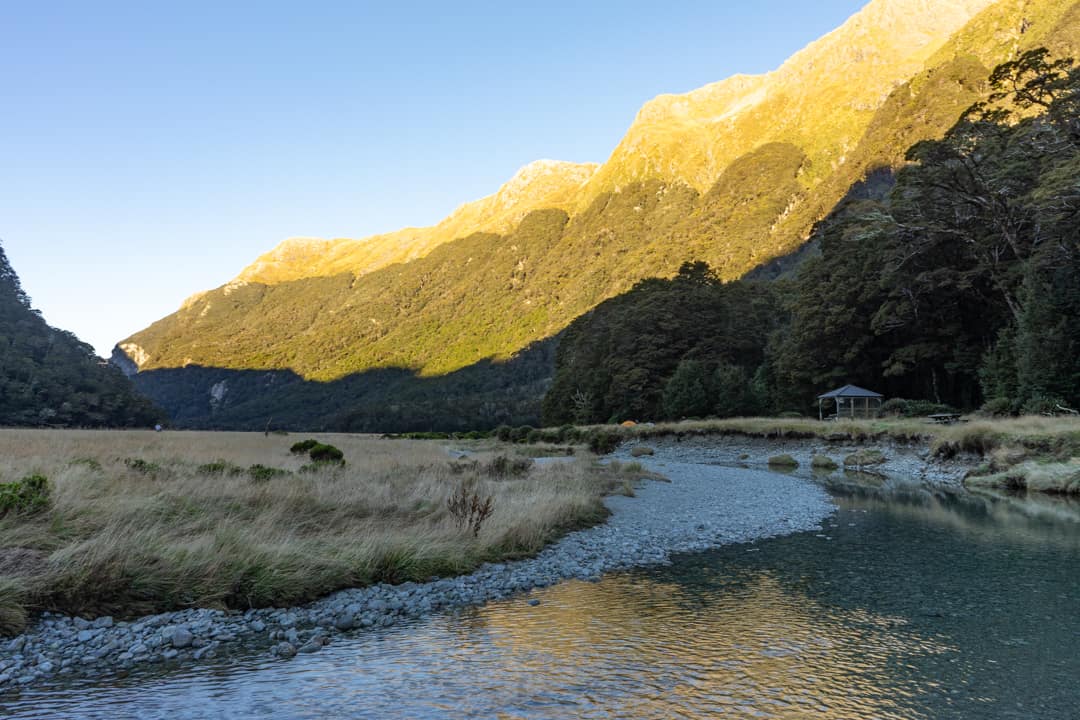
Hut bunks and campsites are limited, so it’s important to get in early (a couple of months in advance if you can) to book your Routeburn hike or you may find you have to change your dates. Keep an eye on the DOC website for updates on when bookings are open.
Prices also vary quite significantly between hut stays and camping, and there is a different price for locals and international trekkers. We each paid $20 per night for our campsites. By contrast, the huts were $130 per person, per night.
What Should I Pack?
We’re hopeless at packing light, but when you’re hiking for three days and carrying everything you need, weight really matters. Especially on those damned climbs.
As we were camping, we carried everything we needed: tent, pegs, roll mats, sleeping bags, food for three days, water bottles, cooking gas and burner, bowls, utensils and clothes. We opted for dehydrated dinners to save on grams. They deserve a post all their own (!).
Routeburn weather is also a serious factor when packing. It can change at a moment’s notice, leaving you (and your gear) cold, wet and unhappy if you aren’t prepared, particularly if you’re camping. Layers, warm clothes, rain gear, and backpack liners or heavy duty garbage bags to protect the stuff inside your pack, are a must, no matter when you go.
We tramped in late April, in the final days of the Great Walks season. While we lucked out with blue skies and warm days for most of the hike, we ended up wearing every single layer we’d packed on the freezing cold nights in our tent.
There are plenty of sites offering guidance on what to pack for a multi-day hike – check out the DOC packing list.
How Do I Get To And From The Routeburn Track?
For us, this was the most expensive element of hiking the Routeburn. As both ends of the trail are in out-of-the-way places which aren’t serviced by public transport, you need to make arrangements for a drop-off and pick up, or a car transfer.
The Routeburn Shelter is around 70km from Queenstown. The Divide is on the Te Anau/Milford Highway, 85km from Te Anau and 34km from Milford Sound.
There are a handful of transport operators running both scheduled and private shuttles to and from both ends of the Routeburn. A couple of companies will also collect your car from one end of the track and move it to the other while you’re hiking.
This is the option we went with. It was pricier than shuttles (though not by much when all was said and done), and it meant we were paying for days of car hire that we didn’t use.
But we preferred the flexibility of travelling on our own terms and having our car waiting for us when we arrived at The Divide. That way, we were able to carry on with our travels without having to backtrack or fuss with multiple car hires.
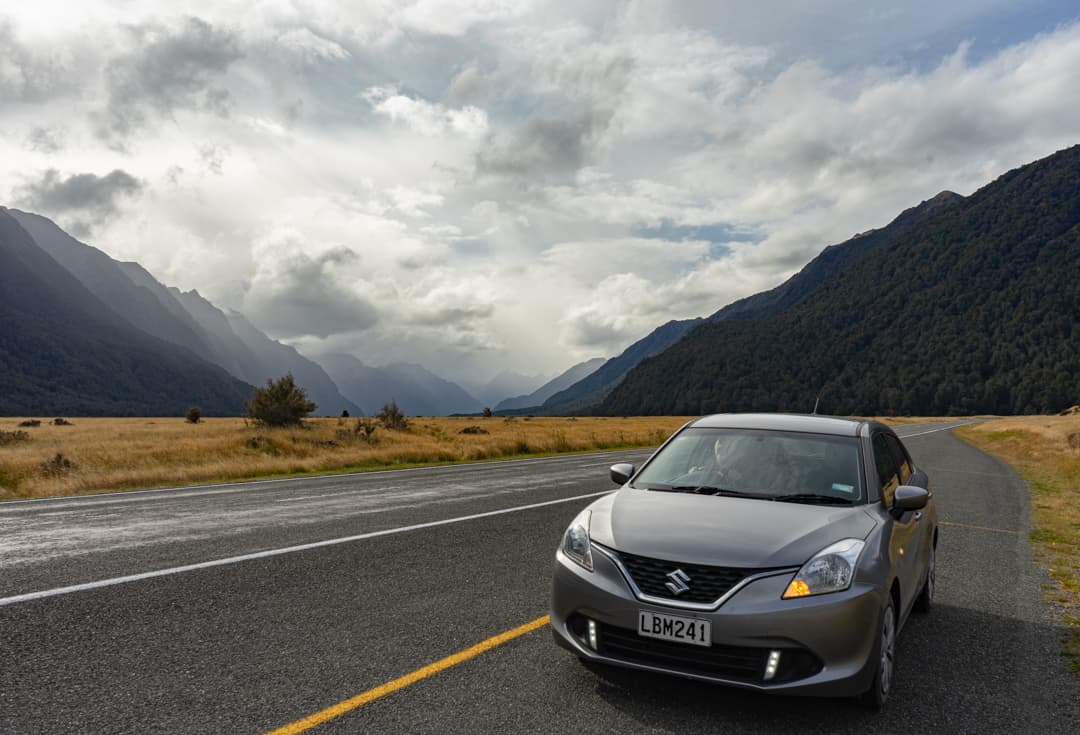
Now you have the basics for planning a hike on the Routeburn. Let’s get tramping NZ style!
Our Self-Guided Routeburn Track Itinerary: 3 Days/2 Nights From Routeburn Shelter To The Divide
While the Routeburn Track can be hiked in either direction, we decided to trek north-east to south-west, from Routeburn Shelter to The Divide, in keeping with our New Zealand South Island road trip plans. Here’s our itinerary.
Day 1 – Routeburn Shelter To Routeburn Flats
Total Distance Appx. 7.5km, Total Time Around 3 Hours
Overnight Routeburn Flats
Our Routeburn adventure starts in beautiful Queenstown, where we load up our hire car on Day 1 and set out on the gorgeous drive along vivid blue Lake Wakatipu to the tiny town of Glenorchy. We’re stopping there to collect a key lock box for our car transfer (see the section above on getting to and from the trail). It’s a 45 minute drive to Glenorchy, so we’re on the road at 10.30am.
Once we’ve got the lock box, we move on to Routeburn Shelter, the trailhead for the Routeburn Track in Mount Aspiring National Park. From Glenorchy, it’s another 30 minutes down a partially unsealed road.
There are clean, flushing toilets at Routeburn Shelter (the last flush loos campers have today, so take advantage).
Our first leg of the Routeburn is relatively short and easy. We’re on the trail at 12.15pm, on a gentle upward sloping path through pretty beech forest and within 15 minutes, we reach a swing bridge, the first of several today. Mountains greet us overhead.
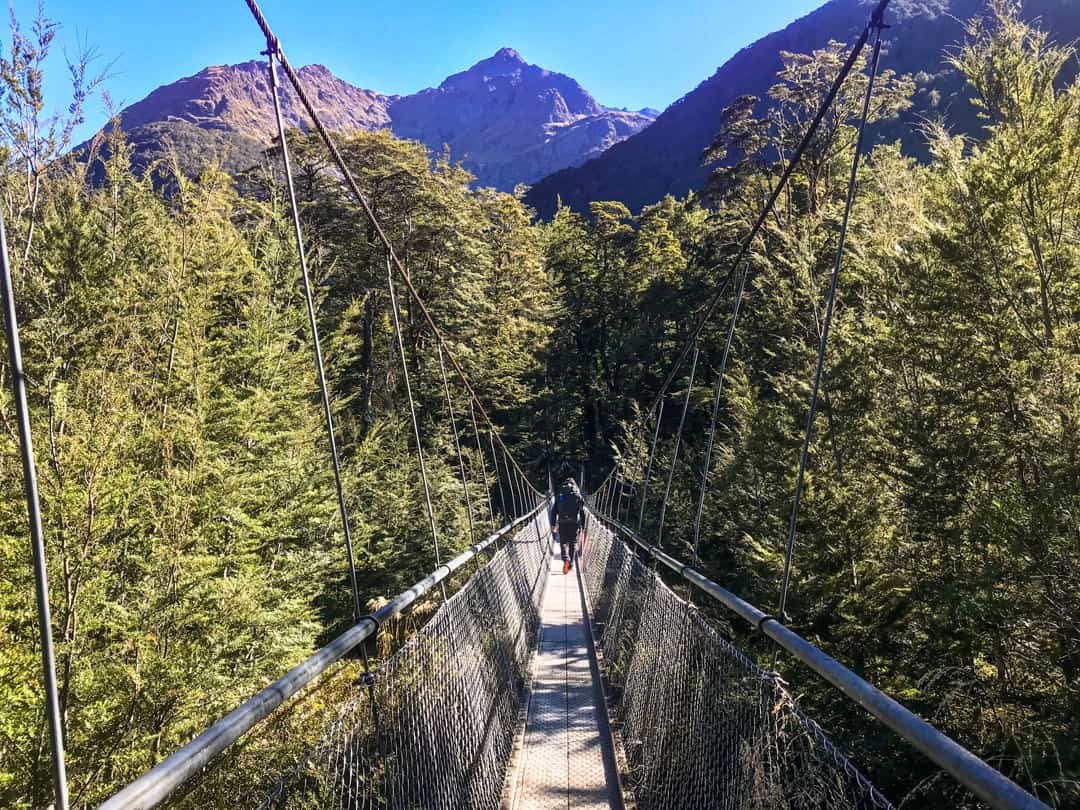
We continue our upward meander, with sunlight dappling the trail through the trees. Soon there are speccy glimpses of the valley far below.
Around 1pm, we arrive at beautiful Bridal Veil Falls and another bridge crossing. Climbing above the gorge, we’re soon moving parallel to the impossibly blue Route Burn river, which has its sources in the Humboldt mountains.
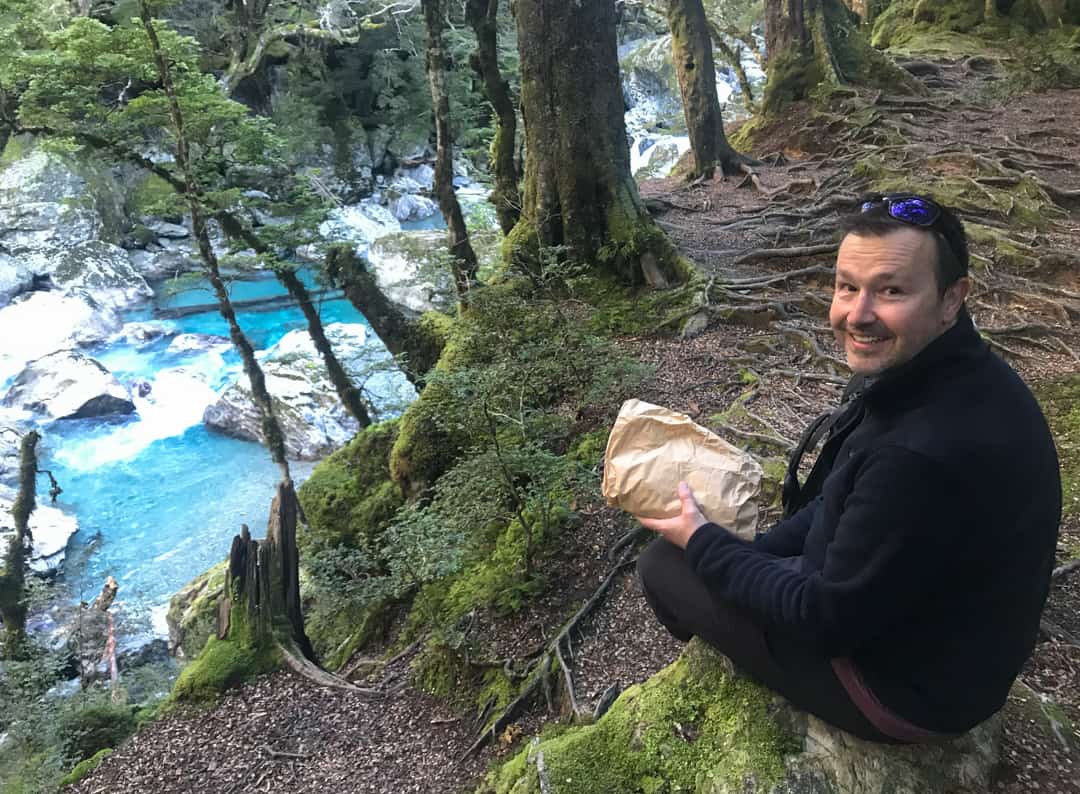
We stop for lunch by this gorgeous rush of water around 1.30pm, and are soon joined by one of the hike’s very friendly locals, a South Island robin. He hops about our feet on the lookout for stray crumbs, and pecks at our water bottles, completely unfazed.
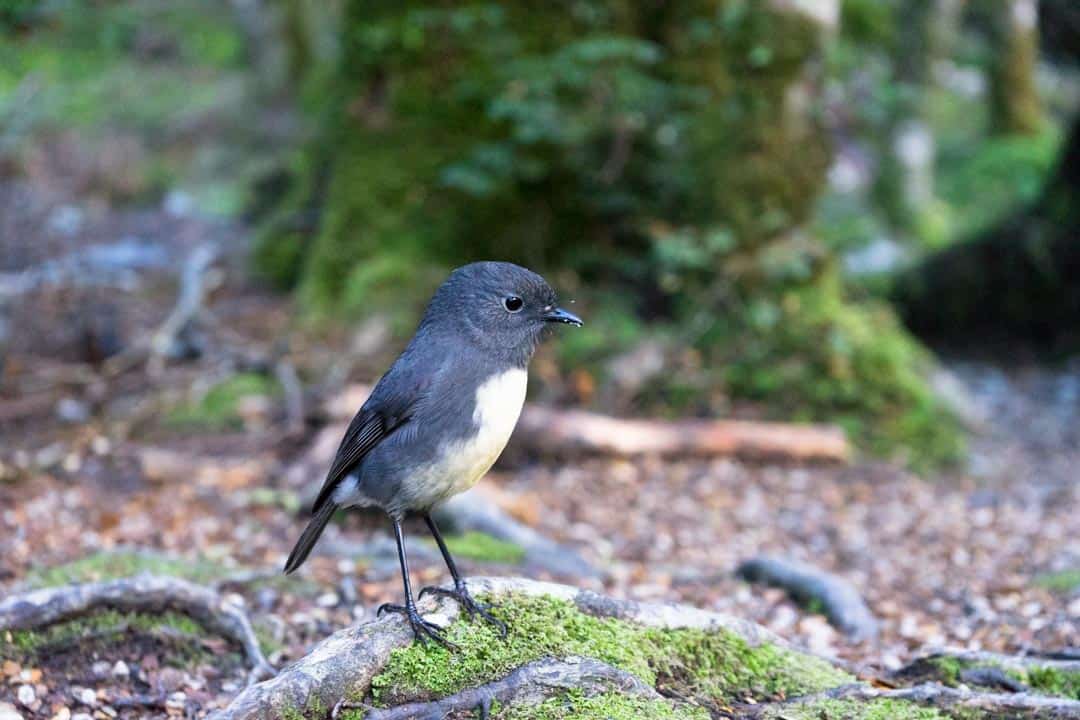
We find a drop toilet conveniently stationed just past our lunch stop.
After a couple more swing bridges, and a photo stop among the boulders and rapids of the Route Burn, we emerge into a lovely grassy valley with mountains rising sheer from the plains. Our stop for the night, Routeburn Flats, is just a little further on.
Track Note: Routeburn Flats is the only first night option for campers starting out from Routeburn Shelter.
If you’re planning to stay in huts though, you can either book to stay here at Routeburn Flats, or at Routeburn Falls, 2.3km further up the track.
If you do opt for Routeburn Falls, we recommend starting today a little earlier as the hike from the Flats is all uphill and takes another 1-1.5 hours.
We shortly reach Routeburn Flats huts through forest edging the valley. The campground is ten minutes past the huts (hut facilities are out of bounds to campers on the Routeburn Track, and both campgrounds are located away from the huts). We arrive around 3.15pm.
Routeburn Flats Campsite
The camping area at Routeburn Flats is a spectacular open grassy space, backed by bushland and looking out on an amphitheatre of snow-smudged mountains. A shallow branch of the Route Burn, paved in smooth pebbles, trickles a winding path in front.
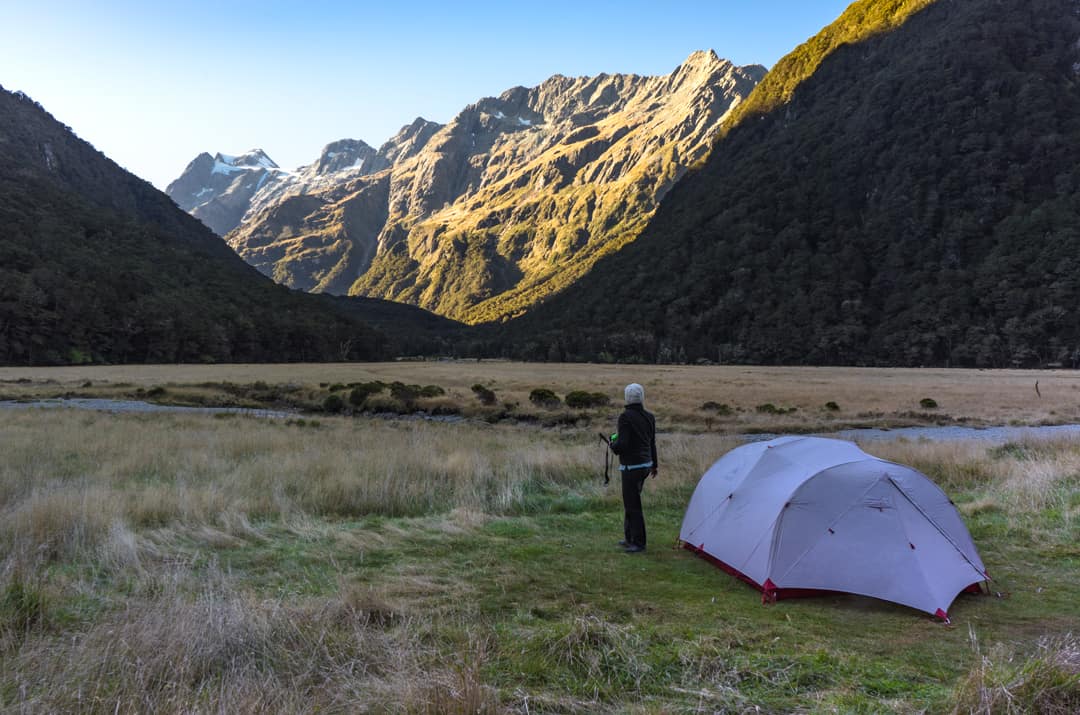
A clean, modern drop toilet hides out of sight among the trees behind the camp. It has toilet paper and hand sanitiser and, as drop toilets go, it’s not bad (we still get the business done quickly). There are also a couple of basic shelters, each with benches, a table and a sink with a cold water tap.
The fifteen campsites here are marked out as flattened spaces in the tall yellow grass. Some have low wooden benches at their head. There’s plenty of space between sites.
We choose a spot and after wandering for a bit, are starting to unpack when we come face to face – quite literally – with what must be the hike’s only undesirable quality: sandflies.
Within moments we’re swarmed, and quickly grab our stuff to find a site further back from the river.
It seems to be the right call as our next spot offers a bit more respite. Still, the tiny biters mean we waste no time putting up our tent, before making a hot drink and climbing in to enjoy the last of the day with the safety of tent mesh between us and them.
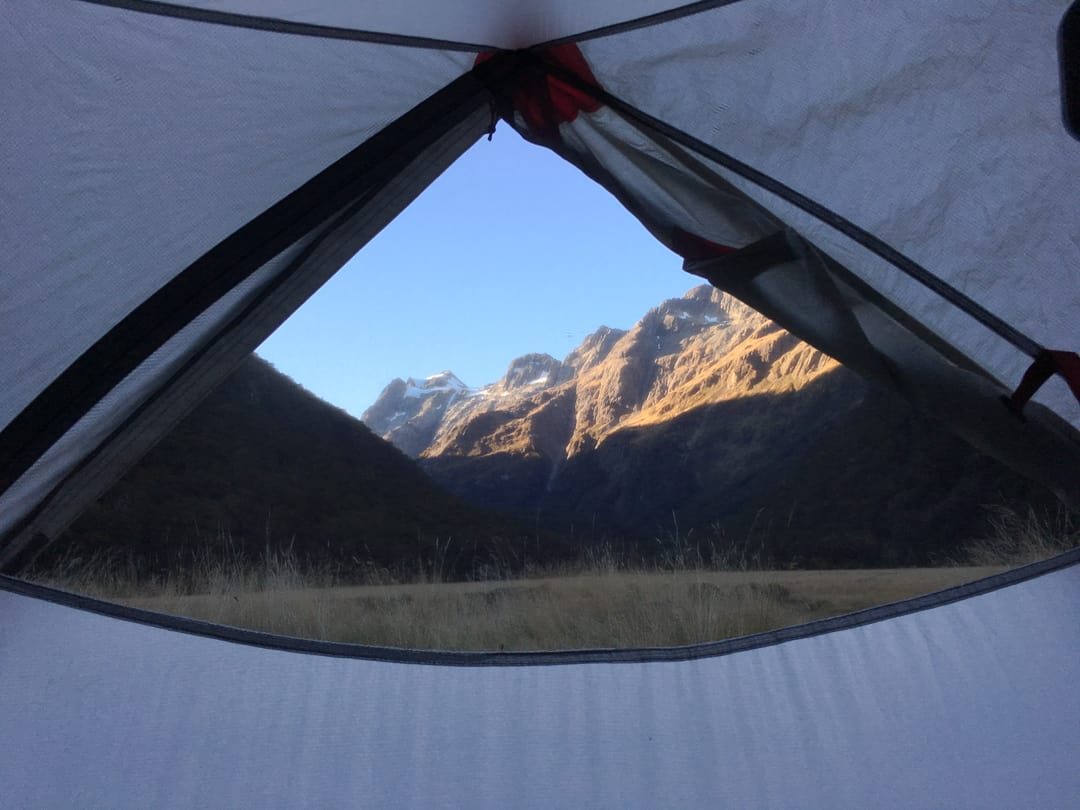
Track Note: Sandflies are actually blood-hungry little black flies and if you stand still, they’ll find you in a flash and bring all their girlfriends. There’s no avoiding them either, they’re part of the New Zealand experience.
Keep moving, or better still, buy a locally made repellent as apparently it’s more effective than the usual concoctions. We stuffed up and forgot repellent altogether = Major Fail.
A friendly ranger drops by our tent a little later to say hi and check we have camping reservations.
Despite a beautifully warm day, the temps drop quickly once the sun goes down and we find our sleeping bags, which are rated to 5 degrees, don’t cut it. We’re grateful at least for the thermals, fleeces, neck warmers and beanies we’ve packed and after a warm dinner and some stargazing, we’re tucked up by 9pm.
Day 2 – Routeburn Flats To Lake Mackenzie
Total Distance Appx. 12.6km, Total Time Around 7.5 Hours
Overnight Lake Mackenzie
1st Leg: Routeburn Flats to Routeburn Falls
(appx. 2.3km, around 1 hour 15)
We’re up with the dawn on Day 2 of the Routeburn trek, and emerge to rising mist, and a heavy frost that’s powdered the valley white and coated our tent in a layer of ice.
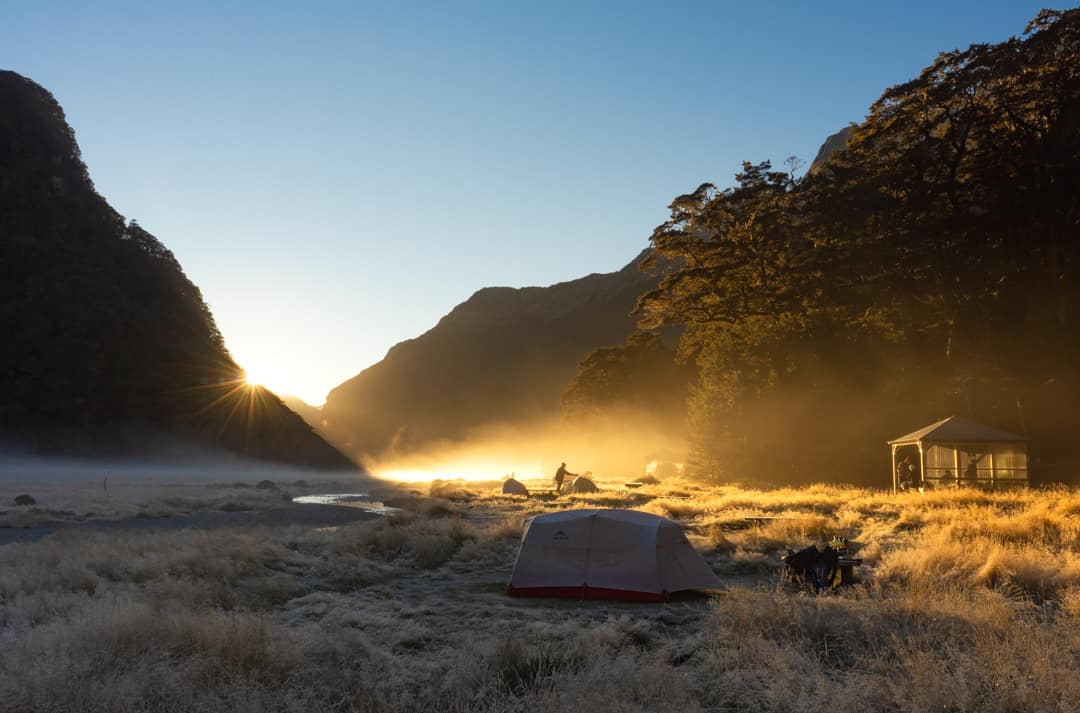
After a warm brekky of coffee, oats and berries, we de-ice the tent (with a cloth we’ve packed for this very purpose), pack up our site and hit the trail at 9am.
It’s a steady climb out of Routeburn Flats to Routeburn Falls and while we start with a dozen layers, we’ve peeled everything off again within fifteen minutes.
Crossing a narrow bridge, we reach one of Routeburn’s most iconic viewpoints about 45 minutes in: a spectacular panorama over the valley we camped in last night surrounded by the Humboldt mountains.
We haul into Routeburn Falls around 10.15am, and stop for a bit to snack and admire the views from this beautiful, mountainside stay. There are flush toilets here and boards with weather advice.
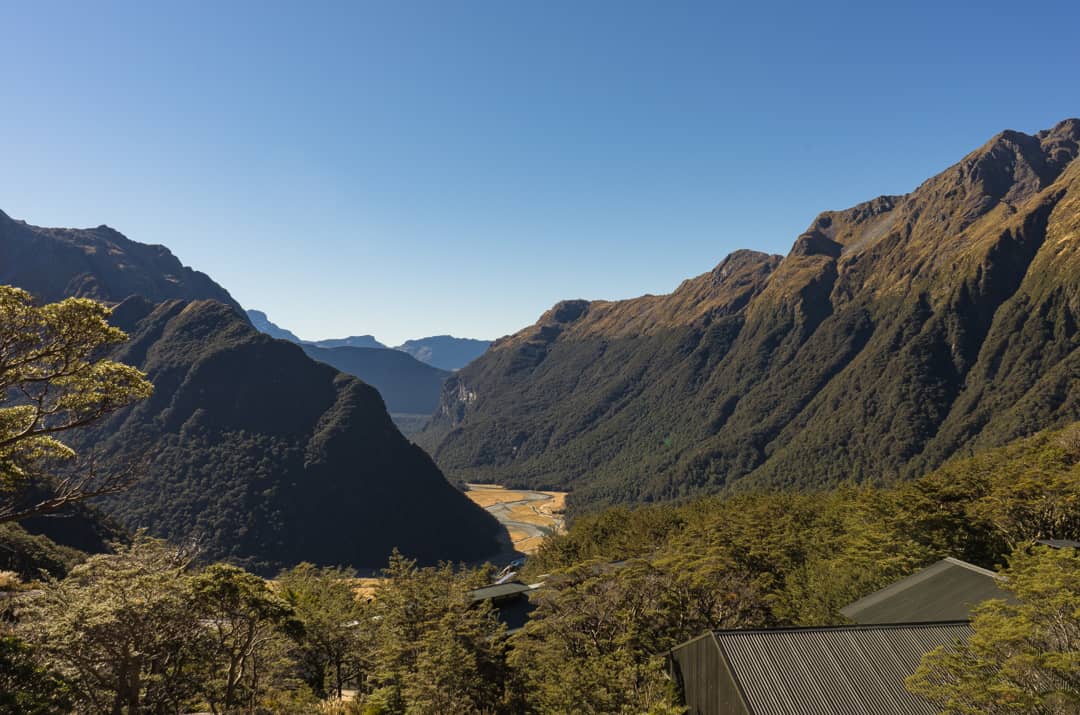
2nd Leg: Lake Howden to The Divide
(appx. 3.4km, around 1.5 hours)
We’re back on the trail at 10.45am. About a minute from the huts, we pass the actual Routeburn Falls, a series of pretty cascades. Some serious climbing starts now as we make for Harris Saddle, the highest point on the Routeburn Track at 1,255m.
The initial climb is steep but we’re soon passing through a wide, beautiful valley before climbing again. It’s tough, exposed and hot. And spectacular. Remember to drink plenty of water on the way up.
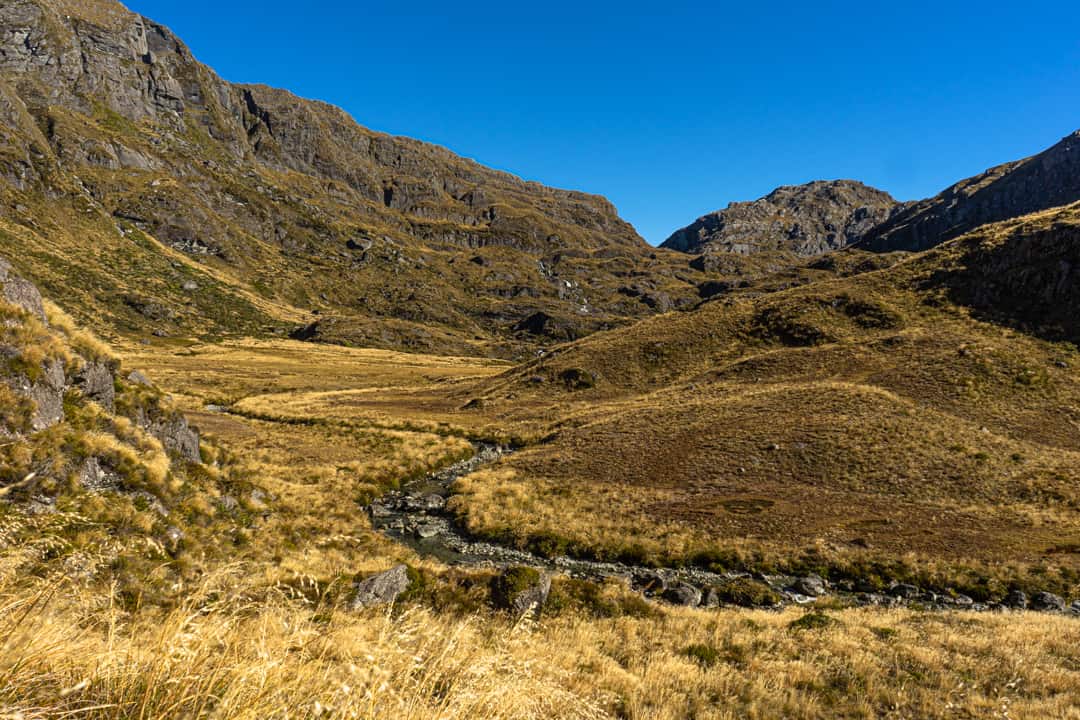
As we pass through an impressive rock arch, sparkling Lake Harris comes into view. We pitch up on a rock to catch our breath, rehydrate and refuel. The epic views over the lake and back down the valley work wonders to rejuvenate us.
Track Note: The crystal clear water in the fast-moving river and streams along the Routeburn looks very inviting, but can you drink it?
The DOC takes a conservative view and suggests while the water is fine for the most part, to be on the safe side, treat it or boil it first.
We sipped from some streams, with no apparent side effects. We usually just filled our bottles at the shelter taps though. No problems there either.
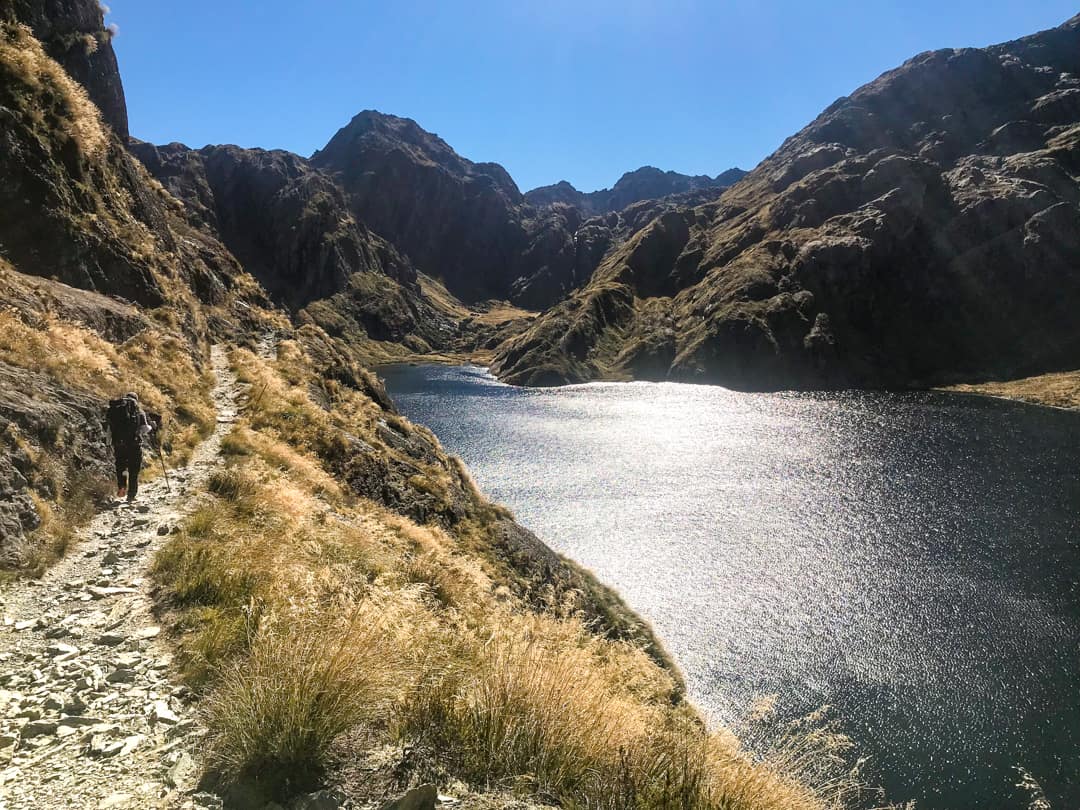
From our perch, we travel along a narrow path above Lake Harris before finally reaching the huts at Harris Saddle around 1pm. We stop here for 30 minutes for lunch and a toilet break.
There are two huts at Harris Saddle, one for independent hikers, the other for guided groups. These huts are basic shelters and aren’t for sleeping. There are a couple of whiffy drop toilets out the back, but no water for refills so make sure you top up before leaving Routeburn Falls.
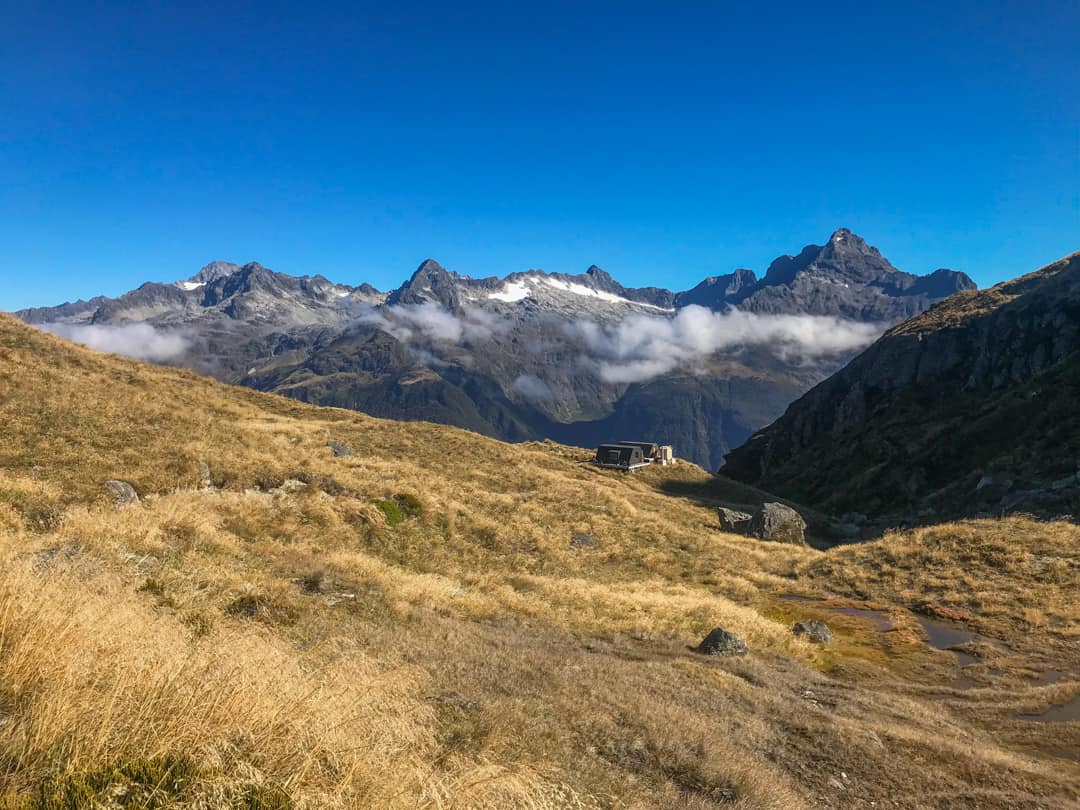
Side trip: If you’ve made good time today and still have plenty of energy, consider a side trip from Harris Saddle up to the peak of Conical Hill at 1,515m.
The steep trail leads from the huts and takes 1-2 hours return. Weather can dictate whether this is a go or not, but if the skies are clear, the views out to the Tasman Sea are apparently outstanding.
With another 3-4 hours of hiking ahead of us, and with shorter daylight hours in late April, we opt to keep going and leave Conical for next time.
3rd Leg: Harris Saddle to Lake Mackenzie
(appx. 6.9km, around 3.5 hours)
Our final leg on Day 2, from Harris Saddle to Lake Mackenzie, involves an eye-popping mountain ridge amble, followed by a doozy of a downhill slog.
After lunching at the Harris Saddle huts, we’re back on the track at 1.30pmand pass around the mountain onto the spectacular Hollyford Face. The panos are vast, with the Darran Mountains soaring above the valley far below.
As we cross Harris Saddle hiking the Routeburn Track, we also pass from Mount Aspiring National Park into Fiordland National Park.
We’ve noticed an intriguing savoury smell along much of the trail from the Falls today, and it’s particularly strong along the Hollyford Face. It could just be us after all the exertion, but we like to think it’s coming from the shrubby alpine herbs growing along the track.
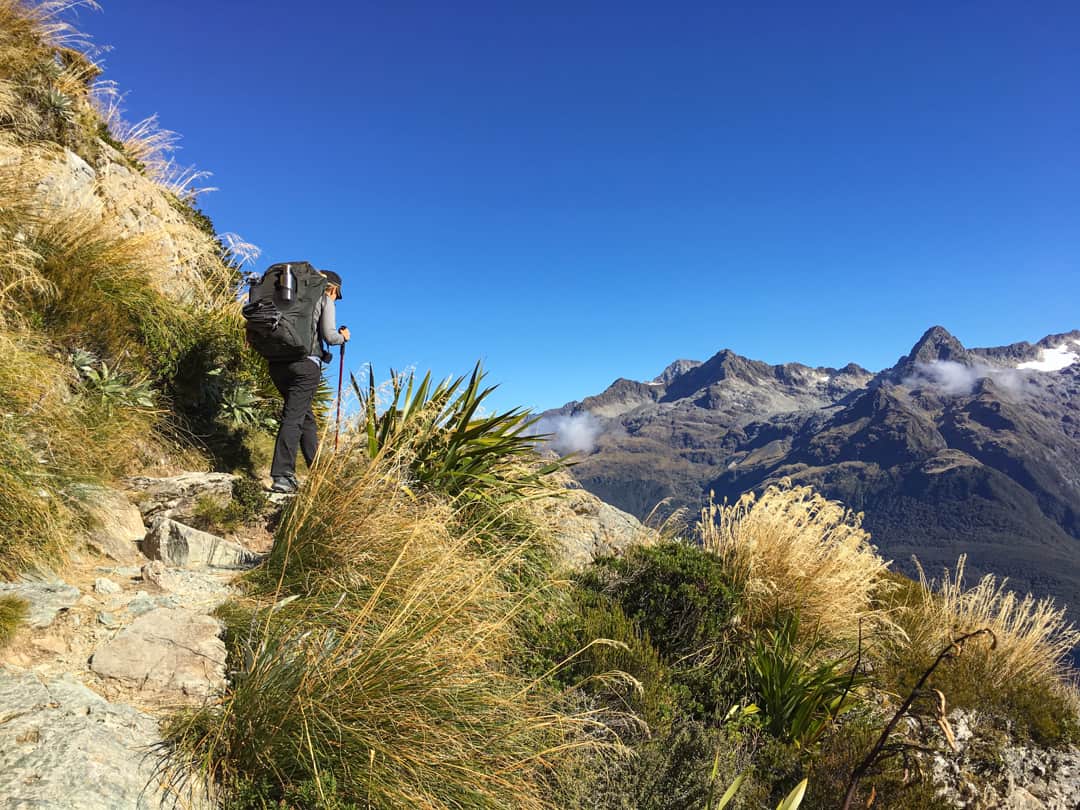
Climbing over a rocky pass, Lake Mackenzie comes into view around 3.30pm. The narrow lake stretches along the valley floor at the foot of a striking, glacier-cut basin. Huge boulders litter the front end of the lake.
The track to Lake Mackenzie huts zig zags down the sheer mountainside. Big steps, loose scree and rubble in places make it a tricky trek.
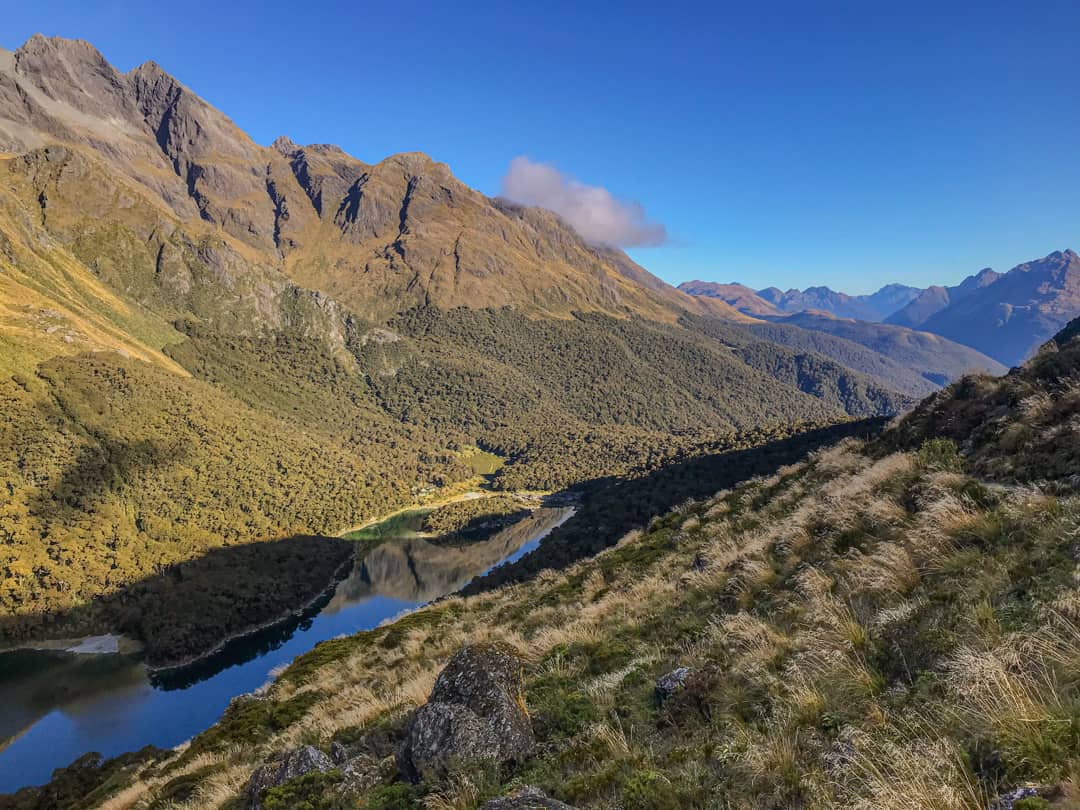
We’re distracted from our protesting knees at one point by the calls of a kea, one of the Fiordland’s most endearing characters. A couple of the cheeky, endangered parrots fly in and perch up nearby to check us out.
Kea are the only alpine parrots in the world, and they’re also among the smartest. They’re known to pinch things from unsuspecting tourists from time to time. We’re thrilled to finally encounter some up close…and walk away with all our gear.
The final stretch of the trail today passes through a gorgeous, mossy forest, vividly green and atmospheric. We’re on a bit of a mission by this stage though, and we emerge at the Lake Mackenzie huts around 4.30pm. The campground is ten minutes on.
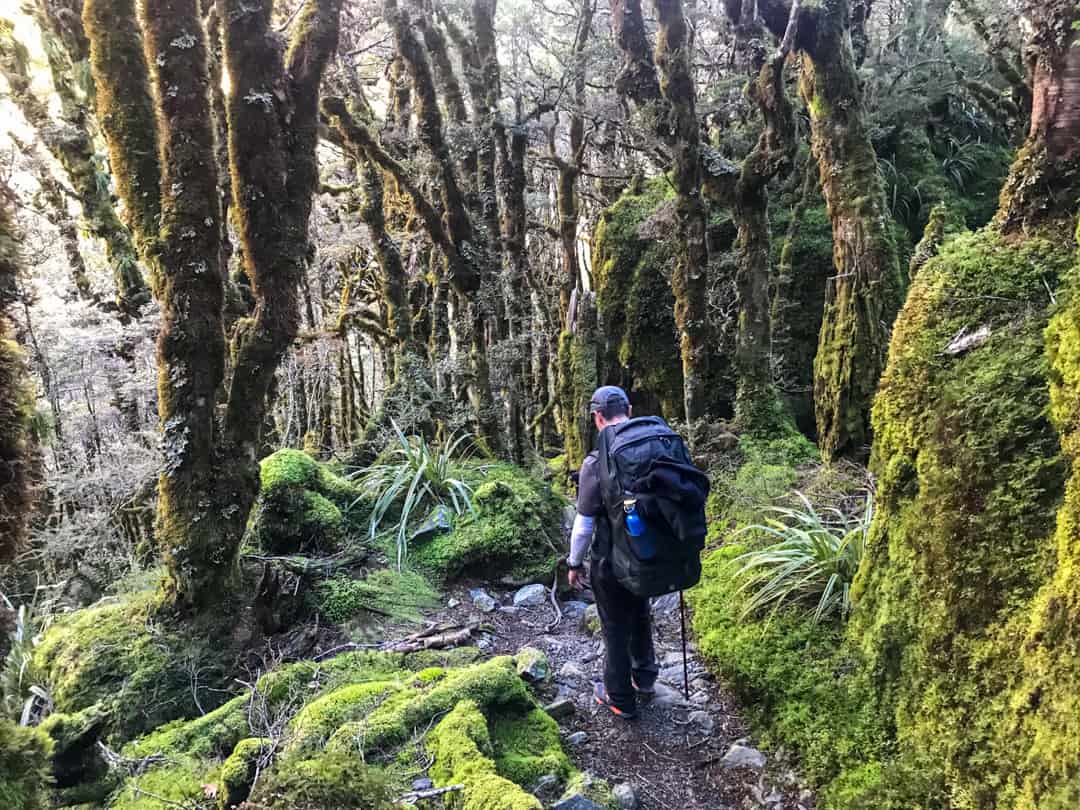
Lake Mackenzie Campsite
The campground at Lake Mackenzie is in a cleared space in the forest: a tight set-up of nine campsites leading off a central pathway.
Each site is separated by low ferns and brush. The ground here is rock hard, so the DOC has built rectangular dirt mounds in each space, covered with something like astroturf, so campers can peg their tents. There were also a bunch of good sized rocks around the tent to lash, weigh and pound with.
Ed’s Note: We were so stoked to arrive, get our packs off and stop moving on Day 2 that we completely forgot to take any pics of the Lake Mackenzie campsite. We took one short video. Here’s a clip from it:
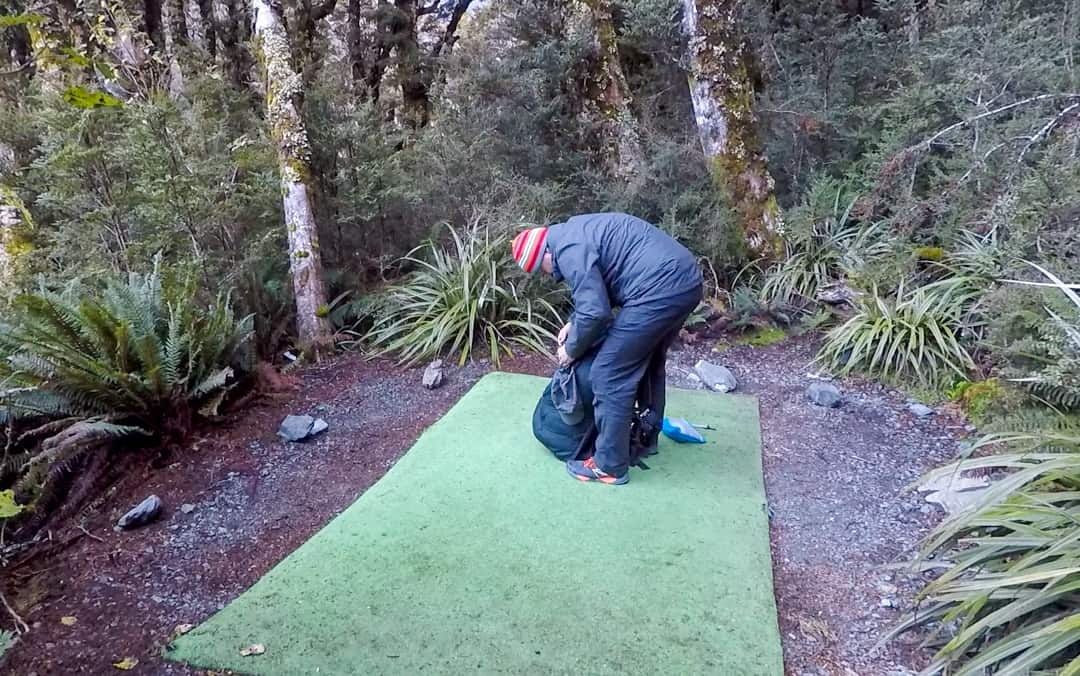
The set-up is tidy, and there’s a good-sized shelter with picnic tables and a long, double-sided bench with sinks and cold water taps.
There are two drop toilets; one is quite new, the other, which is unfortunately the one nearer to us at the top, turns out to be a bit tired and unpleasant. Go for the one closer to the campground entrance.
While the forest surrounds are stunning, we feel a bit more claustrophobic in this campsite after the wide open space of Routeburn Flats. We’re near enough to our neighbours to hear their whispers. Bring earplugs.
Like last night, a lovely DOC ranger pops by the campground in the early evening to check everyone has a Routeburn Track booking.
After setting up our tent and critiquing our way through another couple of rehydrated meals (the jury’s still out on them), we layer up and crawl into our sleeping bags to reflect on another epic day.
Day 3 – Lake Mackenzie To The Divide
Total distance appx. 12km, total time around 6.5 hours
Finish at The Divide carpark
1st Leg: Lake Mackenzie to Lake Howden
(appx. 8.6km, around 4 hours)
It’s mostly downhill for us on Day 3 hiking the Routeburn Track, as we make our way across the range and descend to The Divide.
First though, we have to climb out of the Lake Mackenzie valley. Breakfasted and packed, we’re on the trail at 8.15am, which feels early but we’re among the last to leave.
After a stroll through the boulders at Lake Mackenzie’s edge, past the huts and a stunning guided walks lodge, and through a flat grassy area with the mountains soaring above us, we start the 45-minute climb.
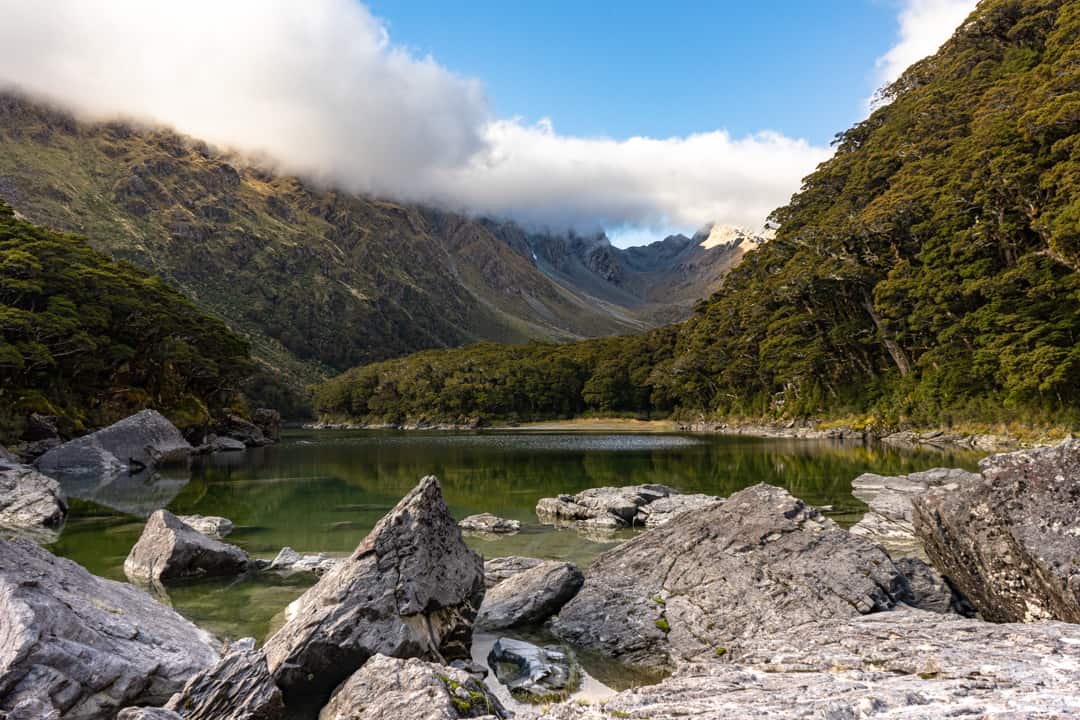
It definitely gets our hearts racing, but continuing on, we’re rewarded a little over an hour later with absolutely spectacular mountain panoramas.
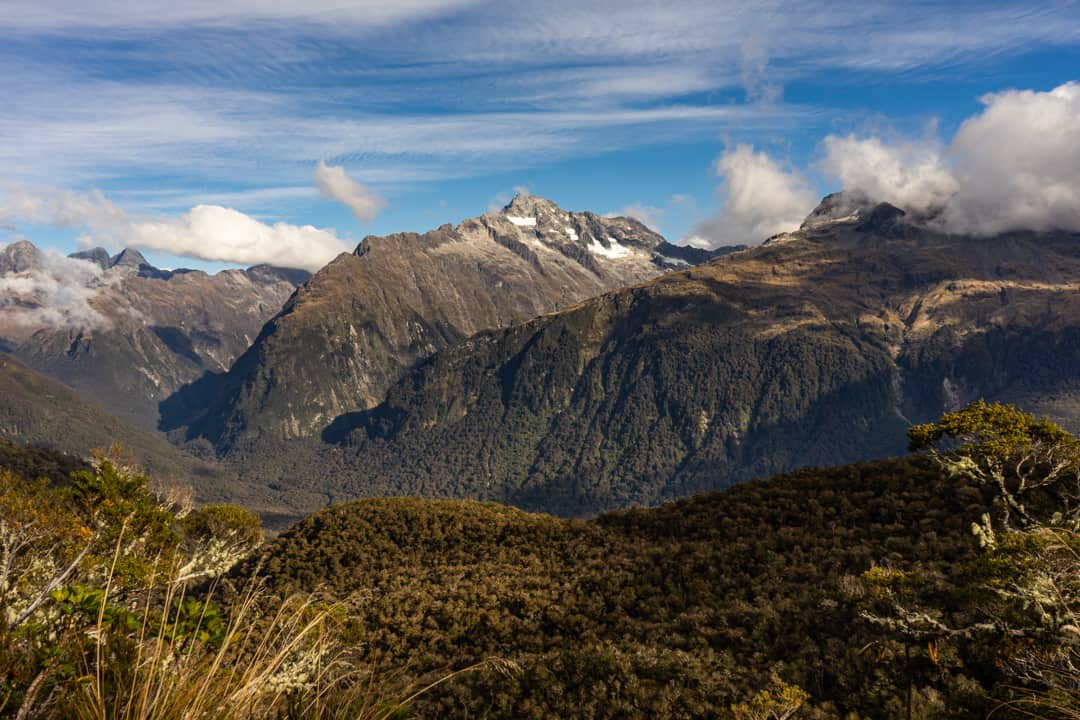
After stopping for a scenic snack, we start a gentle decline that takes us through a lovely place called ‘The Orchard’ and on to Earland Falls, where we arrive around 11am. It’s a picturesque spot with boulder-scattered crystal clear pools at the foot of a 174-metre curtain of water.
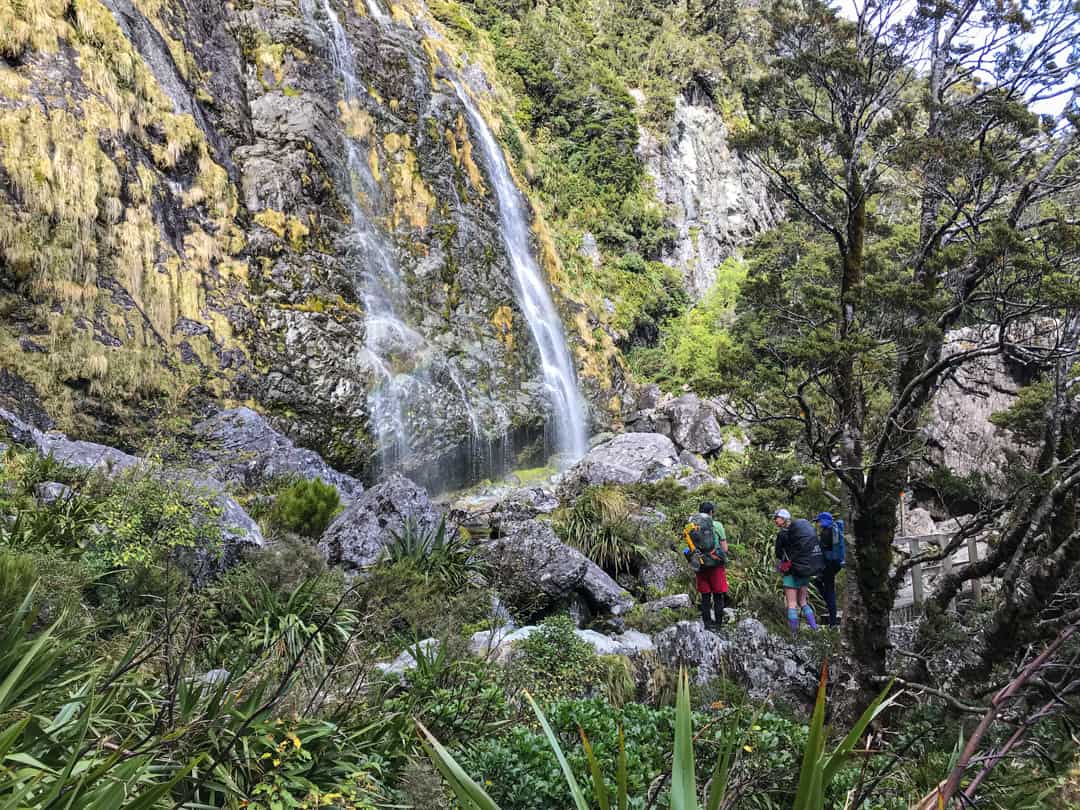
From here, it’s another hour through pretty forest before we pop out to cross a low wooden walkway to Lake Howden hut.
Hikers can book a bed here, or simply ditch their boots on the verandah and enjoy a break in the warmth of the main hut. We drop our bags and ourselves on a bench by the lake with these superb views.
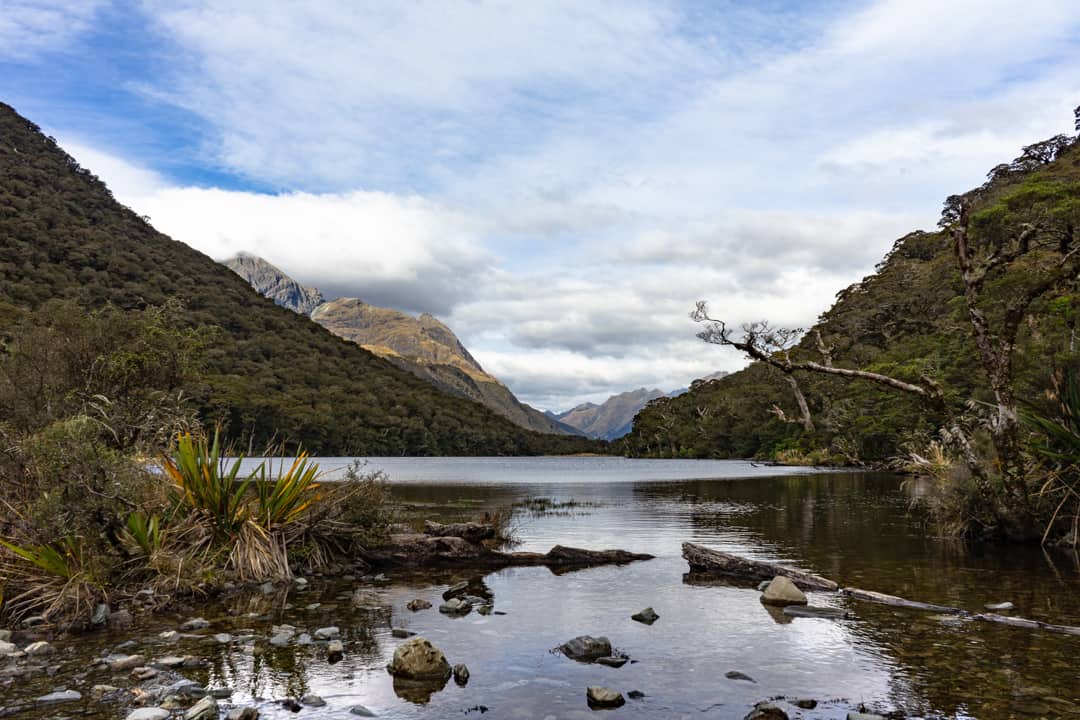
2nd Leg: Lake Howden to The Divide
(appx. 3.4km, around 1.5 hours)
We’re on the home run now. It’s just one more hour to the end of the track and The Divide carpark.
We’ve absolutely lucked out with the weather on our trek, but the weather reports at the huts have forecasted rain at midday today and the clouds have been steadily building all morning.
On cue, as we sit taking in the scene at Lake Howden, a very light rain starts to fall. We’re not keen on waiting around for it to set in, so we cut short our break and get back on the track at 12.15pm.
A few minutes from the hut, we pass what looks like a recent landslide. As we’ve mentioned, the weather can be notorious in this region, and heavy rains forced a landslip that closed this leg of the Routeburn a couple of weeks before we were due to hike. It was reopened just days ahead of our start date.
Had the path remained closed, we would have diverted at this point along another route out called the Pass Creek Track, a route graded Advanced by the DOC. By all accounts it’s a fun slip-and-slide hike along a tramping route that pops out at the lower Hollyford Road.
With rain clouds hot on our heels, we’re grateful to be on the main trail, but it’s a reminder that weather can have a dramatic effect on the Routeburn at any time of the year. Keep an eye on the DOC website and visit a DOC centre before you set out.
It’s a steep, 15-minute upward slog out of Lake Howden. When we reach the top of the rise, we find the turn off to Key Summit, a popular hike that draws lots of day-trippers from Te Anau and Milford for its epic views. By this stage though, the clouds are hugging the peaks behind us and the summit views are closing in, so we decide to keep moving.
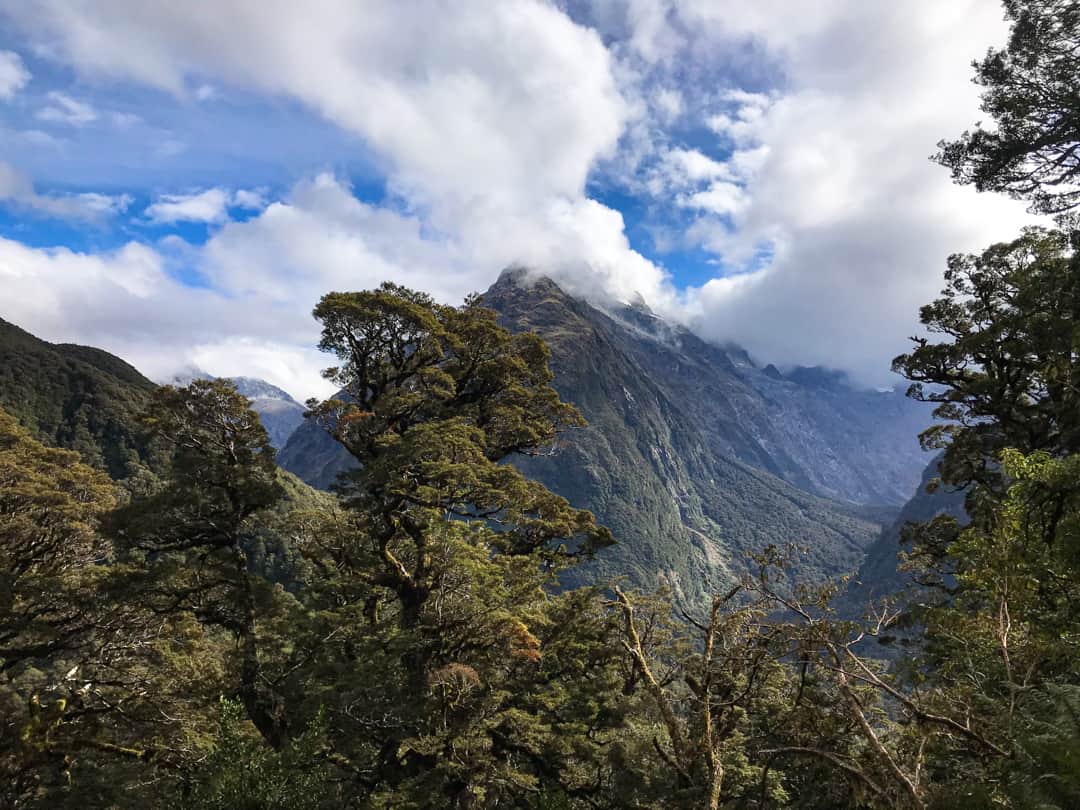
Side trip: For Routeburn trekkers travelling south-west to The Divide, Key Summit is a 20-minute one-way hike off the main track around 15 minutes from Lake Howden hut.
If you’re coming the other way, it’s an hour’s climb from The Divide carpark to the Key Summit turn-off.
The mountain views from the top are said to be phenomenal in good weather, and there’s an alpine tarn (lake) up there too.
Our last stretch is downhill all the way, through pretty forest serving up glimpses of cloud-shrouded peaks to our right. Kea calls accompany us along the way.
Just before we reach the end of the trail, we pass under an archway of branches, an appropriate finish for this incredible trek.
We step out into The Divide carpark at 1:15pm, exhilarated, invigorated and firmly adding the Routeburn Track to our list of favourite walks around the world.
Our car’s waiting for us in the carpark too. Sweet as.
Have you hiked the Routeburn Track, or another one of New Zealand’s Great Walks? Let us know below. And if you have any questions at all about the trek, ask away!
